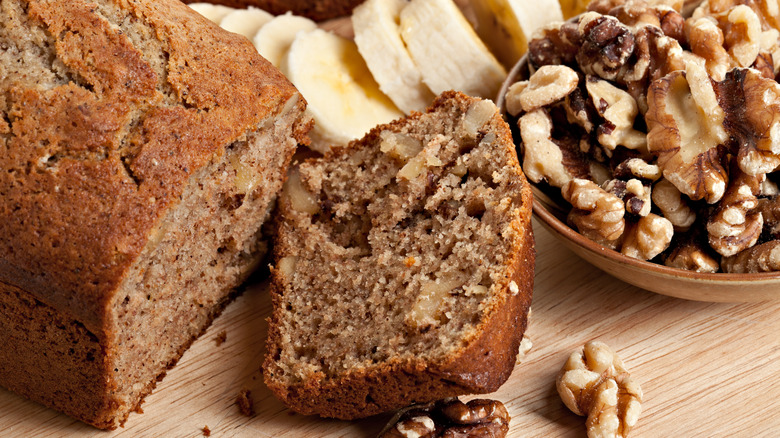The Egg Trick For Making Banana Bread With Unripe Fruit
We banana eaters have a process: Buy relatively unripe bananas at the store, eat one or two when they're ripe, and when they get overripe and turn black — through either chance or intent — crank out a batch of either banana pudding or banana bread; the only thing to do with overripe, squishy Cavendish. But doesn't this mean that your banana bread cravings are always subject to that sliver of time between overripe and rotten? /Not at all, because science! Sure, you can sweeten unripe bananas in the oven, but this process will rob you of precious time. It's entirely possible to transform unripe bananas into their ideal baking state of sweet and mushy, and all you need is a bowl, a potato masher, an egg yolk, and about half an hour — just enough time to assemble all your other banana bread ingredients and preheat the oven.
The good news is that eggs and bananas will already be a part of any extra-moist banana bread recipe, so no worries here. (Obviously, some adjustments will be required, but we'll get to that.) But what in the world does the yolk of a raw egg have to do with ripening bananas? Glad you asked! The poetic answer is the same way that chewing on cooked rice makes it sweeter; the sciencey answer is that alpha-amylase enzymes contained in the yolk catalyze the hydrolysis of the fruit's starch, converting it into the sugary carbohydrate molecules glucose and maltose.
The science of ripening
If you leave green bananas on the counter, they'll ripen on their own. How? Bananas (and other fruits) release a gas called ethylene, which encourages the formation of enzymes in the fruit; namely, alpha- and beta-amylases. These guys begin working on the all-important job of converting starch into sugar — and boy, do green bananas contain a lot of starch. An unripe Cavendish banana is made up of about 21% starch (which is why it basically tastes like a potato); by the time it fully ripens, that amount has fallen to 1%. If you were to somehow be willing to hold a chewed-up slice of green banana in your mouth for about half an hour, it would definitely sweeten up. That's because 10-20% of our saliva is composed of alpha-amylase enzymes. The good news is, egg yolks have a ton of 'em, too, so no one is required to mouth-ripen their green bananas.
Unhatched chicks have yet to know the joys of banana bread, but they need alpha-amylase enzymes nonetheless because they serve as an antibacterial agent protecting the chick by gobbling up carbohydrates — an integral part of many pathogens' infection strategy. For the home cook, amylase-rich egg yolks are the ideal hack for speed-ripening bananas.
Enough with the science! Get to the banana bread part!
Okay: unripe bananas, meet egg yolk, and do the mash — start with a ratio of one yolk for every four ounces of banana. (Four ounces comes out to about 113 grams, and small to large-sized bananas range from around 100 to 135 grams.) Wait, you ask — won't this mess up the recipe? Some adjustments will definitely be required, but remember that additional egg yolks will only make the resulting bake more moist and delectable.
If you're not hyped about dumping a bunch of egg yolks into your banana mash, simply use fewer and give the process more time; say one hour instead of 30 minutes. Alternatively, you can compensate by simply adding the same number of egg whites as beaten eggs called for in the recipe. Of course, this entire process depends on how many bananas and eggs your recipe calls for, and how unripe the fruit is to begin with. Experimentation and reliance on your home baker's instinct are key, and trust us — the rewards will be sweet. Now, when was the last time you made delicious banana pancakes, muffins, or cookies?


